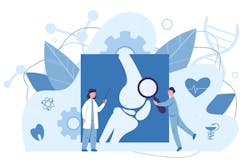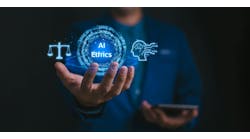As described in Healthcare Innovation’s Ten Transformative Trends May/June cover story package, “The phenomenon of artificial intelligence (AI), which encompasses machine learning, has been the subject of tremendously hyped speculation and commentary for several years now in healthcare. A star area of endeavor at recent annual conferences sponsored by HIMSS (the Chicago-based Healthcare Information & Management Systems Society) and RSNA (the Oak Brook-Ill.-based Radiological Society of North America), AI ended up being weighted down with enormous expectations, and inevitably, as a result, the concrete results have lagged behind those Mount Everest-high expectations.”
Still, even in the midst of the current COVID-19 pandemic, clinician and non-clinician leaders in patient care organizations nationwide are moving forward to adopt AI and machine learning technologies and apply them to patient care delivery and patient care organization operations. One physician leader whose organization has been moving forward with alacrity in the area of ambient voice is William Silver, M.D., medical director of the Triangle Region of the Durham-based EmergeOrtho, a 100-plus-orthopedist orthopedics group that serves patients in 21 counties across North Carolina, from 49 offices. Dr. Silver, who has practiced orthopedics for 17 years, is the official medical director of one of the organization’s regions, and the de facto medical director of the entire organization.
Silver and his fellow orthopedists have been using products from the Burlington, Mass.-based Nuance, including Dragon Speaking Naturally, for years; but moving to the Nuance Dragon Ambient eXperience (DAX) solution, he notes, means that “I literally don’t have to interact with the computer at all; I start the summary, I talk to the patient just as I did back in the days when I had to dictate; but I’m not interacting with the computer.” And that, he says, is where the future lies—with unencumbering the physicians—practicing in all specialties, and in primary care—in order to remove from them the tasks (including keyboarding for physician documentation) that are continuing to cause physician burnout. As Silver notes, those efforts speak to the concept of the Quadruple Aim—the revised Triple Aim of healthcare system advance proposed years ago by the Boston-based Institute for Healthcare Improvement (IHI), which had already focused on care quality and patient safety improvement, cost control, and an improved patient experience, with the added goal of improving the working lives of clinicians.
Below are excerpts from the longer interview that Healthcare Innovation Editor-in-Chief Mark Hagland conducted this spring with Dr. Silver, regarding this important subject.
From your perspective, what has changed with regard to ambient voice, very recently?
Here’s an analogy: for this story, you’re interviewing me, and you’re taking notes, typing, perhaps recording, to get quotes. Wouldn’t it be great just to have a system doing that seamlessly in the background, transcribing the comments, and producing it for editing? In other words, dramatically reducing the amount of time involved? So as I’m seeing patients virtually these days, very few in person, I start the product at the start of my telemedicine call with my patient, and honestly, I don’t interact with the product; it’s literally transcribing everything. It’s hard to do an orthopedic visit through telemedicine, but I can ask patients do push on their knee, see the range of motion, etc. And I’ll say, OK, here’s your diagnosis, and this is what we’re going to do; it helps them understand the process and become engaged; and I lay out the plan for them. And it helps the system.
In the past, would you have been typing anything during a visit?
Absolutely. We’ve all heard the stories of sitting with your back to the patient; or worse, physicians spending 3-4 hours at night after the family is in bed. And there’s always a risk to the accuracy. It’s always good to have things in patients’ own words, and far more accurate to have it done immediately.
Were you at all surprised at how well it functions, at first?
I guess I would say I was. We had one person stopping using the platform, but is back on it now again. For busy surgeons, the need is for efficiency; the more patients we can see, the more efficient and productive we can. The one person who had a problem was a hand surgeon, and was seeing 60 patients a day. And so as soon as I’m done with the patient, I can push stop.
What has been your experience of the difference between this and the old Dragon Speaking?
With the old Dragon Naturally Speaking, I’d still have to go to the microphone, and speak into it. That might add three or four minutes to the visit. Some providers will use Dragon Naturally Speaking who aren’t super-busy. Frankly, it’s a quality-of-life gain. I’ve compensated by adding in a few more patients; but I’ leaving the office at 5 PM. In the old days, it would take me an hour and a half.
How do you see ambient voice evolving forward, and what will happen for physicians as a result?
From a physician standpoint, there are three areas: the EMR side, built based on governmental requirements under the HITECH Act, etc.; that’s good for records, but is not particularly physician-friendly. The second container—this is an overlay for the EHR [electronic health record] that allows you to interact much more effectively. And the third element, unrelated to DAX, is the patient-facing portal. Ideally, in the future, all three elements would be even more seamless, where ideally, I’m not even interacting with my HER at all, but just with the DAX system; so that if I need a chart, I turn to DAX; same with an x-ray or diagnostic image. To me, that’s the Holy Grail. It’s allowed me to ramp up in the telemedicine utilization. Prior to three weeks ago, I hadn’t done a real telemedicine visit. We’re doing 1,000 a week now; I’m doing 90-100 a week.
Are technology and the shift to telehealth, together, helping medical practices to move forward, in terms of practice efficiency? Is telehealth helping, in that regard?
I do think it will be helpful. Until recently, payers had resisted telehealth; they didn’t want to spend extra money; but all that’s changed with the pandemic. And once the crisis goes away, we’ll have to merge back towards encrypted platforms, which is fine. You want your physicians doing things at their level. For me, honestly, my value as a healthcare provider is in making difficult diagnoses or clinical decisions, such as whether a patient needs surgery, and then performing the surgery. But in terms of refilling prescriptions and other routine tasks, there are many things that PAs, nurses, etc., can do—especially tasks related to care management, managing people with diabetes, etc., checking in about medical compliance, etc. And it’s a very big thing as far as convenience for the patients. I also feel that my patient visits are a little bit more efficient. And so I think it will help with staffing. And it also gets back to the burnout issue. That’s why many docs retired during meaningful use after 2010, when they felt they had to do things that others could have done. The shift from the Triple Aim to the Quadruple Aim comes in here, in terms of relieving physicians of burdens that cause burnout.
And ambient voice is working out well for specialist physicians?
I do. In every specialty, there’s probably an iterative process in developing ambient voice. But just as back in the day with Dragon Speaking Naturally, we went through that process, as ambient voice becomes embraced by other specialties, it is being rolled out to surgical specialties like ortho, primary care, and some others, and I would imagine that as time goes by, it can keep learning quickly.
Do you have any advice for fellow physician leaders in specialist practices across the country? And would you say that ambient voice is proving to be a “win-win” for physicians and their care teams?
Yes, I would agree that it is. It’s also somewhat inevitable. I don’t think we’ll be interacting a lot with keyboards and Dictaphones and even speech microphones in the future. It’s a no-brainer. As far as advice, it may not appeal to everybody, but I can’t imagine why it wouldn’t. It’s definitely worth giving a try, because for me and for just about everybody I work with, it’s been such a benefit, as well as liberating us from menial tasks, menial labor. My work product isn’t what I type into a note; that’s meant for billing purposes. My true value is what I get out of an interaction with a patient, and the development of a treatment plan. My work product isn’t the note; in terms of doing the main part of my job, and not having to spend nearly as much time to generate the note and ensure its accuracy and immediate rendering, that’s what makes perfect sense to me.


